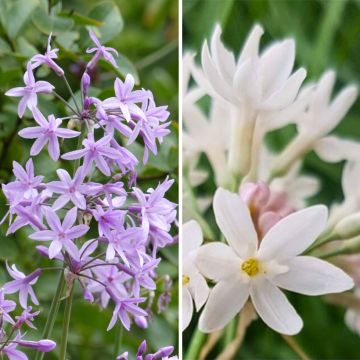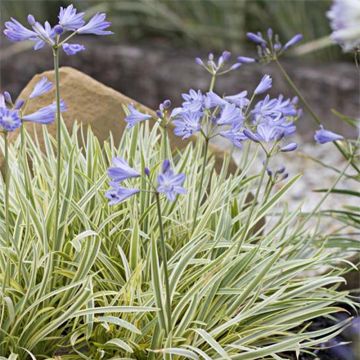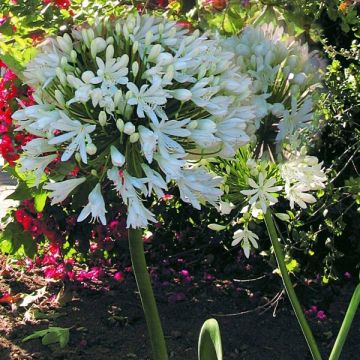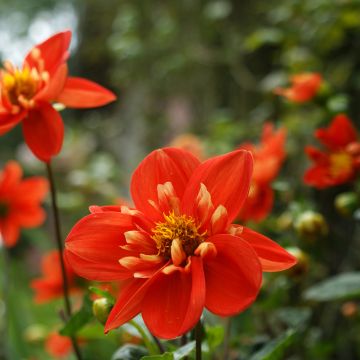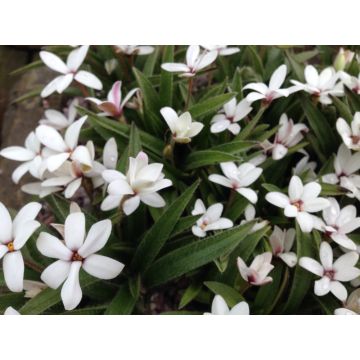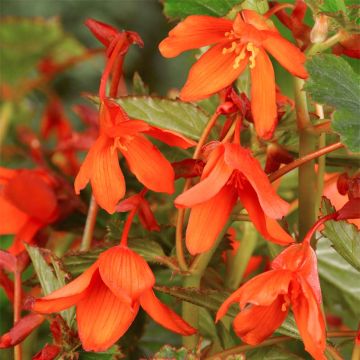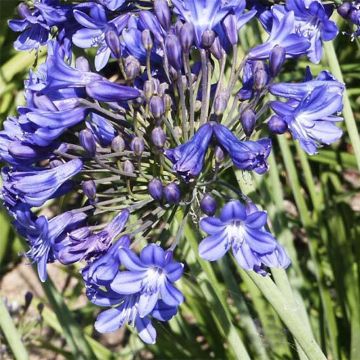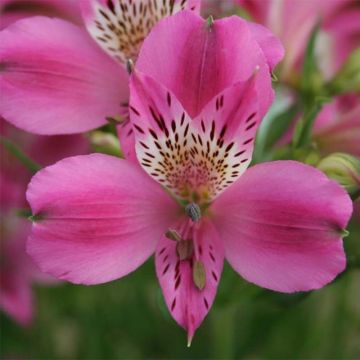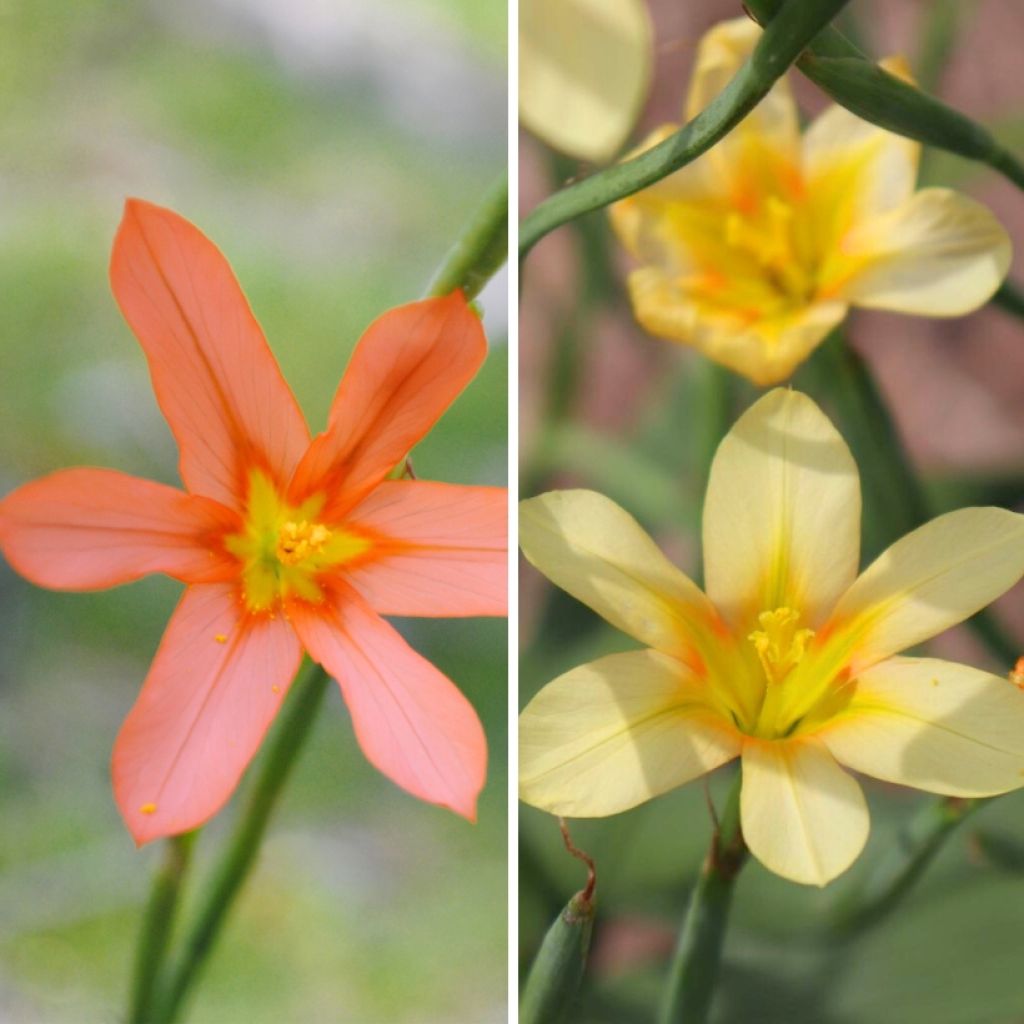

Duo of Homerias - Cape Tulips
Duo of Homerias - Cape Tulips
Homeria flaccida, ochroleuca
Cape Tulip
This plant carries a 6 months recovery warranty
More information
We guarantee the quality of our plants for a full growing cycle, and will replace at our expense any plant that fails to recover under normal climatic and planting conditions.
From €5.90 for pickup delivery and €6.90 for home delivery
Express home delivery from €8.90.
Does this plant fit my garden?
Set up your Plantfit profile →
Collection items (30 plants)
Description
We offer you this Homeria Duo that brings together two distinct species of Cape tulips, Homeria flaccida and Homeria ochroleuca. These bulbous plants have six-petaled flowers in a harmonious range of orange, salmon pink, and yellow tones. The flowering period extends from May to July, depending on the climate and cultivation method. The vegetation consists of long, narrow, upright, bright green leaves. These South African bulbs, not very hardy (-5°C), thrive in open ground in coastal gardens or pots to be stored frost-free during winter. They require well-drained and moderately fertile soil while appreciating a sunny to semi-shaded exposure to fully flourish.
The duo consists of:
x 15 Homeria flaccida (synonym Moreae flaccida): Six-petaled flowers, orange or salmon pink, sometimes entirely yellow. Depending on the climate, flowering from May to July is 50 cm above ground.
x 15 Homeria ochroleuca (synonym Moraea ochroleuca): Pale yellow flowers with an orange heart and a musky fragrance. Flowering from late March to April, at 55-60 cm above ground.
Bulbs labelled separately.
These Cape tulips thrive in open ground in coastal gardens or in pots to be stored during winter. Plant them in well-drained and moderately fertile soil in a sunny location. Cape tulips can be planted in beds, borders, or rockeries. In our climate, they are planted in spring, ideally in April. Plant the bulbs in small groups of 10, spacing them 10 cm apart. They should be planted about 10 cm below the surface of the soil. The vegetation disappears after flowering, while the bulb goes into dormancy. At this time of year, the soil should be dry. Growing them in pots makes it easier to meet the cultivation requirements of Homerias outside the Mediterranean coast.
Report an error about the product description
Plant habit
Flowering
Foliage
Botanical data
Homeria
flaccida, ochroleuca
Iridaceae
Cape Tulip
Moraea flaccida et Moraea ochroleuca
South Africa
Other Homeria
Planting and care
In open ground, plant the Moraea in a sheltered rockery or at the base of a warm and sunny wall in a light, well-drained, humus-rich, moderately fertile soil. Bury the bulbs to a depth of 10 cm. Protect them from moisture in the summer. In a pot, cultivate your Homeria in a mixture of potting soil and sand. Water sparingly when the vegetation emerges from the ground, then regularly throughout the growth and flowering period. Decrease watering as the leaves wither to ensure the dormancy of the bulbs in a dry substrate, which is essential. Overwinter your potted plant in a frost-free but unheated room.
In theory, this bulbous plant begins growing in autumn, retains its foliage in winter, and flowers in spring. Throughout this period, the growing substrate should, therefore, remain moist.
The Cape tulip does not tolerate frost below -5°C. In areas with borderline hardiness, place a thick mulch over the stumps.
Planting period
Intended location
Care
This item has not been reviewed yet - be the first to leave a review about it.
Bulbs to grow in pots
Haven't found what you were looking for?
Hardiness is the lowest winter temperature a plant can endure without suffering serious damage or even dying. However, hardiness is affected by location (a sheltered area, such as a patio), protection (winter cover) and soil type (hardiness is improved by well-drained soil).

Photo Sharing Terms & Conditions
In order to encourage gardeners to interact and share their experiences, Promesse de fleurs offers various media enabling content to be uploaded onto its Site - in particular via the ‘Photo sharing’ module.
The User agrees to refrain from:
- Posting any content that is illegal, prejudicial, insulting, racist, inciteful to hatred, revisionist, contrary to public decency, that infringes on privacy or on the privacy rights of third parties, in particular the publicity rights of persons and goods, intellectual property rights, or the right to privacy.
- Submitting content on behalf of a third party;
- Impersonate the identity of a third party and/or publish any personal information about a third party;
In general, the User undertakes to refrain from any unethical behaviour.
All Content (in particular text, comments, files, images, photos, videos, creative works, etc.), which may be subject to property or intellectual property rights, image or other private rights, shall remain the property of the User, subject to the limited rights granted by the terms of the licence granted by Promesse de fleurs as stated below. Users are at liberty to publish or not to publish such Content on the Site, notably via the ‘Photo Sharing’ facility, and accept that this Content shall be made public and freely accessible, notably on the Internet.
Users further acknowledge, undertake to have ,and guarantee that they hold all necessary rights and permissions to publish such material on the Site, in particular with regard to the legislation in force pertaining to any privacy, property, intellectual property, image, or contractual rights, or rights of any other nature. By publishing such Content on the Site, Users acknowledge accepting full liability as publishers of the Content within the meaning of the law, and grant Promesse de fleurs, free of charge, an inclusive, worldwide licence for the said Content for the entire duration of its publication, including all reproduction, representation, up/downloading, displaying, performing, transmission, and storage rights.
Users also grant permission for their name to be linked to the Content and accept that this link may not always be made available.
By engaging in posting material, Users consent to their Content becoming automatically accessible on the Internet, in particular on other sites and/or blogs and/or web pages of the Promesse de fleurs site, including in particular social pages and the Promesse de fleurs catalogue.
Users may secure the removal of entrusted content free of charge by issuing a simple request via our contact form.
The flowering period indicated on our website applies to countries and regions located in USDA zone 8 (France, the United Kingdom, Ireland, the Netherlands, etc.)
It will vary according to where you live:
- In zones 9 to 10 (Italy, Spain, Greece, etc.), flowering will occur about 2 to 4 weeks earlier.
- In zones 6 to 7 (Germany, Poland, Slovenia, and lower mountainous regions), flowering will be delayed by 2 to 3 weeks.
- In zone 5 (Central Europe, Scandinavia), blooming will be delayed by 3 to 5 weeks.
In temperate climates, pruning of spring-flowering shrubs (forsythia, spireas, etc.) should be done just after flowering.
Pruning of summer-flowering shrubs (Indian Lilac, Perovskia, etc.) can be done in winter or spring.
In cold regions as well as with frost-sensitive plants, avoid pruning too early when severe frosts may still occur.
The planting period indicated on our website applies to countries and regions located in USDA zone 8 (France, United Kingdom, Ireland, Netherlands).
It will vary according to where you live:
- In Mediterranean zones (Marseille, Madrid, Milan, etc.), autumn and winter are the best planting periods.
- In continental zones (Strasbourg, Munich, Vienna, etc.), delay planting by 2 to 3 weeks in spring and bring it forward by 2 to 4 weeks in autumn.
- In mountainous regions (the Alps, Pyrenees, Carpathians, etc.), it is best to plant in late spring (May-June) or late summer (August-September).
The harvesting period indicated on our website applies to countries and regions in USDA zone 8 (France, England, Ireland, the Netherlands).
In colder areas (Scandinavia, Poland, Austria...) fruit and vegetable harvests are likely to be delayed by 3-4 weeks.
In warmer areas (Italy, Spain, Greece, etc.), harvesting will probably take place earlier, depending on weather conditions.
The sowing periods indicated on our website apply to countries and regions within USDA Zone 8 (France, UK, Ireland, Netherlands).
In colder areas (Scandinavia, Poland, Austria...), delay any outdoor sowing by 3-4 weeks, or sow under glass.
In warmer climes (Italy, Spain, Greece, etc.), bring outdoor sowing forward by a few weeks.




































